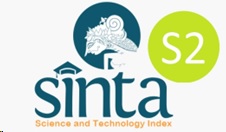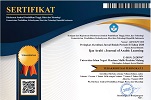Approaches Of Arabic Education Research: Criticism And New Offers Of Methodology Diversification
Abstract
Research of Arabic Education (AE) is a systematic investigation of interesting research questions about the Arabic language. Arabic Education Research can use a variety of approaches, types, and designs. For this reason, diversification of research methodology is needed so that it is not concentrated in certain research approaches and types. This study aims to describe: (1) the approach and type of research used by students in thesis research; (2) mastery of scientific substance and research methodology of students; (3) weaknesses that occur in student thesis writing. This research is descriptive-quantitative. Data collected by documents and interviews. Data were analyzed with percentages and reflective thinking. The results showed that: (1) most students conducted research using a quantitative approach, with the type of experimentation, and quasi-experiment design, (2) the substance and methodology of the students showed good mastery, and (3) weaknesses that occurred in student thesis writing lies in the weakness in making research abstracts and discussing research results. For this reason, it is suggested the need to increase students' insights in the field of research methodology, so that student research is not focused on specific approaches and types of research, so that it spreads to all approaches and types of research. However, the choice of approach and type of research must still adjust to the scientific characteristics and the problem under study.
Keywords
Full Text:
PDFReferences
Ainin, M. (2013). Penelitian Pengembangan dalam Pembelajaran Bahasa Arab. OKARA: Jurnal Bahasa dan Sastra, Vol. II, Tahun 8, November 2013, p. 95-110.
Ainin, M. (2014). Metodologi Penelitian Peningkatan Kualitas Pembelajaran Bahasa Arab (Teori dan Praktik). Malang: Bintang Sejahtera
Annesley, T.M. (2010). "The Discussion Section: Your Closing Argument." Clinical Chemistry 56 (November 2010): 1671-1674.
Arikunto, S. (1992). Prosedur Penelitian, Suatu Pendekatan Praktik. Jakarta: RinekaCipta.
Asmawan, M. C. (2016). Analisis Kesulitan Mahasiswa Menyelesaikan Skripsi. Jurnal Pendidikan Ilmu Sosial, Vol 26, No.2, Desember 2016, p. 51-57.
Bell, J. (1999). Doing Your Research Project. Buckingham: OUP.
Best, K. (1995).Research in Education. New Delhi: Prentice-Hall of India.
Borg, W.R. & Gall, M.D. Gall. (1989). Educational Research: An Introduction, Fifth Edition. New York: Longman.
Brannen, J. (1992). Mixing Methods: Qualitative and Quantitative Research. Burlington: Ashgate Publishing.
Budescu, G. and Walker, B.L.E (2012). Social Scientists and Research Development: What Do Research Development Professionals Do? American Sociological Association, Footnotes, February 2012, p. 3;
Coryn, C.L.S. (2006). The Fundamental Characteristics of Research. Journal of MultiDisciplinary Evaluation, Number 5, September 2006.
Creswell, J.W. (1994). Research Design, Qualitative & Quantitative Approaches. California: SAGE Publications, Inc.
Creswell, J.W. (2007). Qualitative Inquiry & Research Design, Choosing Among Five Approaches. London-New Delhi: SAGE Publications.
Creswell, J.W. (2008). Educational Research, Planning, Conducting, and Evaluating Quantitative and Qualitative Research. Columbus, Ohio: PEARSON Merrill Prentice Hall.
Creswell, J.W. (2014). Research Design, Qualitative, Quantitative, and Mixed Methods Approaches. (Fourth Edition). United State of America: Sage Publications.
Cross, N. (ed.) (1984). Developments in Design Methodology. Chichester, UK: John Wiley & Sons.
Crotty, M. (1998). The Foundations of Social Research: Meaning and Perspective in the Research Process. London: SAGE Publications Inc.
Curedale, R. (2013). Design Research Methods: 150 Ways to Inform Design. Topanga, CA: Design Community College Inc.
Etika, N. & Hasibuan, W.F. (2016). Deskripsi Masalah Mahasiswa yang Sedang Menyelesaikan Skripsi. Jurnal KOPASTA, 3 (1), (2016) p. 40 – 52.
Failasuf, C. (2015). Analisis Kecenderungan Penelitian Mahasiswa Jurusan Bahasa Dan Sastra Arab Fakultas Bahasa Dan Seni Universitas Negeri Jakarta. Jurnal AL-MA'RIFAH. Volume 12 No. 1, April 2015, p. 70 – 83.
Feigenbaum, E.A.&McCorduck, P. (1983). The Fifth Generation: Artificial Intelligence and Japan's Computer Challenge to The World. Reading, MA: Addison-Wesley.
Furchan, A. & Maimun, A. (2005). Studi Tokoh, Metode Penelitian Mengenai Tokoh. Yogjakarta: PustakaPelajar.
Gay, L.R., Mills, G.E., Airasian, P.W. (2012). Educational Research, Competencies for Analysis and Applications. New Jersey: Pearson Education, Inc.
Gill, T. G. (2011). Informing with the Case Methods: A Guide to Case Methods Research, Writing, and Facilitation. California: Informing Science Press.
Jalil, M, M. (2013). Practical Guidelines for Conducting Research - Summarising Good Research Practice in Line with the DCED Standard (February 2013). Available at SSRN: https://ssrn.com/abstract=2591803 or http://dx.doi.org/10.2139/ssrn.2591803
Kaul, L. (1984). Methodology of Educational Research. New Delhi: Vikas Publishing House.
Kasiram, H.M. (1993). Petunjuk Operasional Penelitian. Makalah Lokakarya Penelitian Se IAIN Sunan Ampeldan Kopertais Wilayah IV. Malang: FT IAIN SunanAmpel.
Koskinen, I., Zimmerman, J., Binder, T., Redström, J., Wensveen, S. (2011). Design Research Through Practice: From The Lab, Field, and Showroom. Waltham, MA, USA: Morgan Kaufmann.
Krippendorff, K. (2006). The Semantic Turn: A New Foundation for Design. Boca Raton, FA: CRC Press.
Kumar, V. (2012). 101 Design Methods: A Structured Approach for Driving Innovation in Your Organization. Hoboken, NJ: Wiley.
Kyrillidou, M. (2016). What's your Story? Introduction to Research Design for Libraries and Information Services. LLAMA Webinar, September 26, 2016.
Laurel, B. (2003). Design Research: Methods and Perspectives. Cambridge, MA: MIT Press.
Lodico, M. G., Spaulding, D.T., Voegtle, K.H. (2010). Methods in Educational Research, From Theory to Practice. San Francisco: John Wiley & Sons, Inc.
Lubis, N. (2001). Naskah, Teks, dan Metode Penelitian Filologi. Jakarta: Yayasan Media Alo Indonesia.
Mason, E. and Learned, L. (2006). The Role of "Development" in a Research Administration Office. J. Res. Admin. 37(1): 23-34.
McCombes, S. (2020). How to Write an Abstract. Date published February 28, 2019, Date updated: January 23, 2020. https://www.scribbr.com/dissertation/abstract/
McMillan, J.H. (2008). Educational Research, Fundamentals for Consumer. Fifth Edition. Boston: Pearson Education, Inc.
Moleong, L.J. (1990). MetodologiPenelitianKualitatif. Bandung: RemajaRosdakarya.
Muqim, M. (1994). Research Methodology in Islamic Perspective. New Delhi: Genuine Publications & Media Pvt, Ltd.
Musthafa, I. &Hermawan, A. (2018). Metodologi Penelitian Bahasa Arab, Konsep, Dasar, Strategi, Metode, Teknik. Bandung: RemajaRosdakarya
Newman, I. ,& Benz, C.R. (1998). Qualitative-Quantitative Research Methodology: Exploring The Interactive Continuum. Carbondale: University of Illinois Press.
Puspita, C.A (2019). Factors Affecting Students' Difficulties In Writing Thesis, A Mixed-Methods Research at Eighth Semester of English Study Program in IAIN Curup. 3rd English Language and Literature International Conference (ELLiC) Proceedings, Vol. 3, 2019.
Ralph, N., Birks, M., & Chapman, Y. (2015). The Methodological Dynamism of Grounded Theory. International Journal of Qualitative Methods, 14 (4), 1– 6.
Ramdani, S. &Setiadi, B. (2014). Trends of Research Methodology of Thesis In Vocational Education Yogyakarta State University. Conference: The 3rd International Postgraduate Colloqium of Research in Education, At Bandung, Volume: 3, 2014.
Richey R. & Klein, J. (2007). Design And Development Research: Methods, Strategies and Issues. Mahwah, New Jersey: Lawrence Erlbaum Associates, Publishers.
Sugiyono (2006). MetodePenelitian Pendidikan, Pendekatan Kuantitatif, Kualitatif, dan R & D. Bandung: Alfabeta.
Swales, J.M. and Feak, C.B.(2009). Abstracts and the Writing of Abstracts. Ann Arbor, MI: University of Michigan Press, 2009.
Tashakkori, A. &Teddlie, C. (1998). Mixed Methodology, Combining Qualitative and Quantitative Approaches. California: SAGE Publications.
Waas, T., Verbruggen, A, Wright, T. (2010). University research for sustainable development: definition and characteristics explored. Journal of Cleaner Production. Volume 18, Issue 7, Mey 2010.
Yin, R. K. (2009). Case Study Research: Design and Methods (4th Ed.). Thousand Oaks, CA: Sage Publications, Inc.
DOI: https://doi.org/10.18860/ijazarabi.v3i2.9595
Refbacks
- There are currently no refbacks.
Copyright (c) 2020 Agus Maimun
License URL: https://creativecommons.org/licenses/by-sa/4.0/













